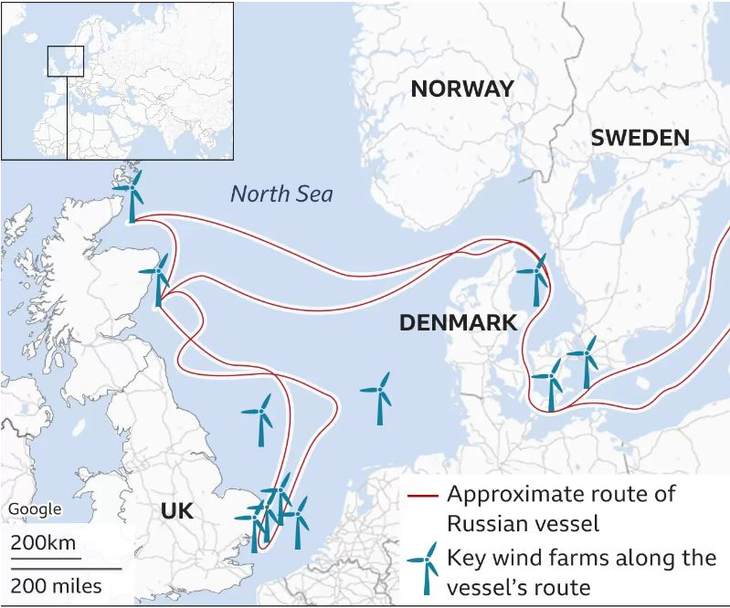A joint investigation carried out by broadcasters in Norway, Sweden, Denmark and Finland found that Russian spy ships are traversing the North Sea and gathering information on undersea infrastructure. These ships are officially registered as fishing trawlers or ocean research vessels but they frequently turn off their location transponders and travel around the locations of offshore windfarms and undersea cables.
A Russian “spy” ship stopped at sites around wind farms in the North Sea – including off the Scottish coast – in order to gather intelligence, an investigation by European broadcasters claims.
A joint report by broadcasters in Denmark, Sweden, Finland and Norway claims the ship Admiral Vladimirsky was part of an operation to map undersea infrastructure.
While officially classified as an ocean research vessel, the report says it is part of a fleet which is examining key energy sites for possible sabotage.
These ships are known as “ghost ships” because they make efforts to avoid having their movements tracked. But news outlets were able to find one of these ships, the Admiral Vladimirsky, by intercepting Russian communications which were coming from the Russian navy. They then sent a small boat out to meet the ship.
The communication reveals that there are Russian “ghost ships” sailing in the Nordic waters . Ships which have turned off their so-called AIS transmitters and thus do not share their locations.
On the basis of the intercepted radio communication, DR was therefore able to locate the Russian naval ship north of Sjællands Odde in November.
A journalist and a photographer from DR sailed out and found the large vessel in the waters between Sjællands Odde and Grenaa.
This clip comes from the joint documentary. As soon as the boat approaches the Russian “research vessel” Admiral Vladimirsky masked men with military rifles take up positions on deck.
The Russian ship "Admiral Vladimirsky" is in the documentary series "Shadow war" a team of investigative journalists from DR, NRK, SVT and Yle revealed how Russia is waging a hybrid war in the Nordic countries and with spies, troll armies, advanced underwater programs and secret… pic.twitter.com/ofLinClvTP
— Selshevneren (@selshevneren) April 19, 2023
Here’s a close up of one of the Russian military guys on deck.
Russia is preparing large-scale sabotage against the infrastructure of Denmark, Norway, Finland and Sweden.
DK, NRK, SVT and Yle broadcasters revealed the activities of Russian intelligence. Military "ghost ships" of the Russian Federation move in the Baltic and North Seas. They… pic.twitter.com/qlpZS6wW9V
— Malinda 🇺🇸🇺🇦🇵🇱🇨🇦🇮🇹🇦🇺🇬🇧🇬🇪🇩🇪🇸🇪 (@TreasChest) April 19, 2023
Analysts agree the point of all of this activity is to prepare possible sabotage missions.
Intelligence sources and experts estimate that the aim of ‘Admiral Vladirmirsky’s’ mission in our waters was to prepare sabotage, so that Russia has the opportunity to paralyze, among other things, the power supply in North-West Europe…
More specifically, the Russian naval vessel has probably mapped power cables on the seabed at the offshore wind farms, assesses the independent naval analyst HI Sutton.
Here’s a map published by the BBC showing the route of the vessel.

And that’s just one of many Russian ghost ships that the investigation found moving around the North Sea. In fact by looking over ship traffic data they were able to identify 50 ships that seemed to be sailing around the area in suspicious ways over the past 10 years. But the activity seems to have surged relatively recently.
In February, Dutch intelligence issued an unusual official warning about activity that could indicate preparation for disruption or sabotage of marine infrastructure. The head of the country’s military intelligence said a Russian ship had been detected near a wind farm in the North Sea and was mapping out sites.
“We saw in recent months Russian actors tried to uncover how the energy system works in the North Sea. It is the first time we have seen this,” General Jan Swillens said.
There have also been a few acts that might have been sabotage though who is responsible isn’t entirely clear.
The report raises the possibility that such vessels were linked to an incident south of Svalbard last year when an underwater data cable was cut.
The cable served the world largest commercial ground station for satellite communications. Norwegian police have said they believe “human activity” was behind the sabotage but have not officially accused anyone.
And of course there was the sabotage of the Nord Stream pipeline. That was initially blamed on the Russians but since then fingers have pointed at the US and Ukrainians.
Some amount of spying on neighbors in entirely normal. Still, since the invasion of Ukraine last year and the application of Sweden and Finland for NATO membership (Denmark and Norway were founding members), the situation has changed.







Join the conversation as a VIP Member